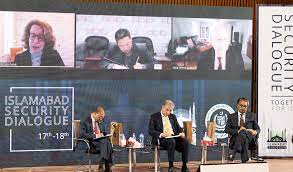On the last day of the two-day ‘Islamabad Security Dialogue’ conference, Pakistan COAS Gen. Javed Qamar Javed Bajwa said that all disputes with India should be settled peacefully through dialogue. He stressed Islamabad continues to believe in using diplomacy to resolve all outstanding issues, including Kashmir, to keep the “flames of fire away from our region”. He made the remarks while discussing emerging challenges in international security under the theme “Comprehensive Security: Reimagining International Cooperation”.
His tentative proposal for peace with India suggested having some sort of trilateral dialogue involving India, Pakistan and China to create an inclusive peace. In response, India kept harping
that Jammu and Kashmir “was, is and shall forever” remain an integral part of India.
A major obstacle to the lasting peace is India’s long-cherished desire to become a mini-superpower in South Asia. Regrettably, some influential countries, particularly the USA, buttressed India’s ambition to emerge as a regional bully. India is now a member of forums such as the G-20, a strategic partner to the USA, a member of the anti-China QUAD, and a member of the nuclear Supplier Group.
India aspires to become a permanent member of the United Nations’ Security Council. As far back as March 2005, the USA announced its intention “to help India become a major world power in the 21st century” (K. Alan Konsstadt, CRS Report for Congress: India US Relations, updated February 13, 2007 (Congressional Research Service 2007).
- Raja Mohan says:
‘India’s grand strategy divides the world into three concentric circles. In the first, which encompasses the immediate neighbourhood, India has sought primacy and a veto over the actions of outside powers. In the second which encompasses the so-called extended neighbourhood, stretching across Asia and the Indian Ocean littoral, India has sought to balance influence of other powers and prevent them from understanding its interests. In the third which includes the entire global stage , India has tried to take its place as one of the great powers, a key player in international peace and security’(C. Raja Mohan, India and the Balance of Power, Foreign Affairs July-August 2006 issue). Chanakya, in his magnum opus Arthashastra also talks about mandala (inter-relationships or circles).
Unless the USA adopts a balanced policy concerning nuclear-capable India and Pakistan, always at daggers drawn, peace in the region will remain a far cry.
Henry Kissinger and Zbigniew Brzezinski have exposed India’s ambition to emerge as a hegemon in South Asia as a rival to China.
Kissinger says:
‘Just as the early American leaders developed in the Monroe Doctrine a concept for America’s special role in the Western Hemisphere, so India has established in practice a special position in the Indian Ocean region between the East Indies and the Horn of Africa. Like Britain with respect to Europe in the eighteenth and nineteenth centuries, India strives to prevent the emergence of a dominant power in the vast portion of the globe, just as early American leaders did not seek the approval of the countries of the Western Hemisphere with respect to the Monroe Doctrine, so India in the region of its special strategic interests conducts its policy on the basis of own definition of a South Asian Order’ (Henry Kissinger, World Order, New York: NY:Penguin Press, 2014, p. 205).
Brzezinski points out:
‘Indian strategists speak openly of a greater India exercising a dominant position in an area ranging from Iran to Thailand. India is also positioning itself to control the Indian Ocean militarily, its naval and air power programs point clearly in that direction _ as do politically guided efforts to establish for India strong positions with geostrategic implication in adjoining Bangladesh and Burma’(Zbigniew Brzezinski, Strategic Vision: America and the Crisis of Global Power, New York, NY: Basic Books, 2012, p. 85).
At the conclusion of the recent two-plus-two dialogue, the USA over-ebulliently mentioned Pakistan with negative undertones in the communiqué. The joint statement stated:
‘The Ministers strongly condemned any use of terrorist proxies and cross-border terrorism in all its forms and called for the perpetrators of the 26/11 Mumbai attack, and Pathankot attack, to be brought to justice. They called for concerted action against all terrorist groups, including groups proscribed by the UNSC 1267 Sanctions Committee, such as al-Qa’ida, ISIS/Daesh, Lashkar-e-Tayyiba (LeT), and Jaish-e-Mohammad (JeM), and Hizb ul Mujahideen. The Ministers called on Pakistan to take immediate, sustained, and irreversible action to ensure that no territory under its control is used for terrorist attacks. The Ministers committed to continued exchange of information about sanctions and designations against terror groups and individuals, countering violent radicalism, use of the Internet for terrorist purposes, and cross-border movement of terrorists. The Ministers also emphasized the importance of upholding international standards on anti-money laundering and combating the financing of terrorism by all countries, consistent with FATF recommendations.”
The skewed remarks about Pakistan (as also about Afghanistan) were unwarranted. The dialogue was essentially meant to take stock of the situation emerging from the role of critical and emerging technologies in the new world order. Or, to examine how to further strengthen the QUAD as a bulwark against China.
Unless the USA adopts a balanced policy concerning nuclear-capable India and Pakistan, always at daggers drawn, peace in the region will remain a far cry.























